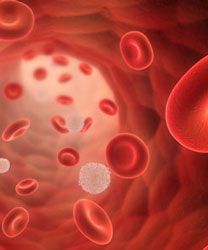Ibrutinib Better Than Bendamustine for OS in CLL, Indirect Comparison Suggests
Results of a systematic literature search published online in Clinical Lymphoma, Myeloma & Leukemia showed that ibrutinib was associated with superior survival and fewer adverse events compared with bendamustine in patients with chronic lymphocytic leukemia.
Blood cells

Results of a systematic literature search published online in Clinical Lymphoma, Myeloma & Leukemia showed that ibrutinib (Imbruvica) was associated with superior survival and fewer adverse events (AEs) compared with bendamustine (Treanda) in patients with chronic lymphocytic leukemia (CLL).
Treatment with ibrutinib was associated with significantly improved overall survival (HR, 0.21; 95% CI, 0.06-0.74; P <.001).
Researchers also found no statistically significant difference in progression-free survival (PFS) determined by Independent Committee between patients treated with ibrutinib and bendamustine (HR, 0.70; 95% CI, 0.40-1.31; P = .398). However, with investigator-determined PFS, the risk of progression or death in the ibrutinib group declined by 70% (HR, 0.30; 95% CI, 0.14-0.65; P =.01). In the bendamustine long-term follow-up data, HR was 0.25 (95% CI, 0.12-0.52; P = .001).
Study coauthor Iga Andrasiak, MSc, a clinical research coordinator with WroMedica Research Center in Wroclaw, Poland, told OncLive that there are no randomized clinical trials comparing bendamustine and ibrutinib in CLL. Because the agents have different mechanisms of action—bendamustine is a purine analogue/alkylator hybrid cytotoxic while ibrutinib is a selective and covalent inhibitor of the enzyme Bruton's tyrosine kinase (BTK)—Andrasiak and her colleagues wanted to compare the agents using indirect comparison.
“Bendamustine is a classical chemotherapeutic agent, whereas ibrutinib is an example of a new class of drugs,” she said. “Our study showed that due to the different mechanism of action of these 2 compounds, despite a higher CR rate in the bendamustine-treated group, ibrutinib is superior in survival. The message for doctors treating CLL patients is that the benefit of BTK inhibitor therapy is not related to CR rate.”
Researchers reviewed data from all randomized controlled trials comparing ibrutinib or bendamustine to chlorambucil in treatment-naïve adult patients with CLL. In studies eligible for inclusion, bendamustine could be administrated as a range from 100 mg/m2 daily per cycle and ibrutinib as a daily dose of 420 mg. Chlorambucil was a considered comparator for both arms as a range of minimum 0.5 mg/kg per cycle.
Primary endpoints were PFS and overall survival.
No trials were found with direct comparison of ibrutinib and bendamustine. Three full-length articles and 3 conference abstracts were included in the analysis.
Researchers found that patients in the bendamustine group were nearly 10 times more likely to have complete response (OR = 9.35; 95% CI, 1.04-84.46; P =.042). However, the odds of patients in the ibrutinib group having partial response were about 6 times greater (OR = 0.16; 95% CI, 0.03-0.87; P <.0001). There was no statistically significant difference in overall response (OR = 0.26; 95% CI, 0.05-1.50; P >.05).
Andrasiak said ibrutinib demonstrated superior survival even though bendamustine produced more complete responses because of the nature of BTK inhibitors.
“This is due to a different mechanism of action of BTK inhibitors, such as ibrutinib and idelalisib [Zydelig],” she said. “Patients treated with these drugs mainly achieve PR with lymphocytosis. Response may be improved, when continuing the therapy with BTK inhibitors.”
Median age in the bendamustine group was 63 versus 73 in the ibrutinib group.
Ibrutinib was associated with far fewer AEs than bendamustine. Patients in the bendamustine group were almost 3 times as likely to experience neutropenia (IRR = 2.97; 95% CI, 1.38-6.36; P = .029) and 4 times as likely to experience grade 3/4 neutropenia (IRR = 3.93; 95% CI, 1.63-9.49; P = .015). Patients treated with bendamustine were also more likely to experience pyrexia (IRR = 4.09; 95% CI, 1.55-10.82; P = .028) and vomiting (IRR = 3.72; 95% CI, 1.44-9.56; P = .036). Researchers did not observe any significant difference in the rate of grade 3/4 thrombocytopenia, anemia, diarrhea, fatigue, cough, nausea, or infections.
“Additionally, adverse events grade 3/4 that occurred in at least 10% of patients in the bendamustine group were neutropenia (23%), thrombocytopenia (12%), [and] leukopenia (14%), whereas in ibrutinib group there was only neutropenia (10%),” Andrasiak said. “Moreover, there were more AE incidences occurring in at least 15% of patients evaluated as grade 3/4 in the bendamustine arm (89 AEs in the group of 161 patients).”
She added that researchers only observed 37 such AEs among 135 patients in the ibrutinib group. The researchers concluded that, based on this analysis, ibrutinib was a safer option than bendamustine overall, but noted that there were 6 incidents of severe bleeding in the ibrutinib group. There were no such incidents with bendamustine.
Andrasiak I, Rybka J, Knopinska-Posluszny W, Wrobel T. Efficacy and safety of bendamustine and ibrutinib in previously untreated patients with chronic lymphocytic leukemia—indirect comparison [published online March 7, 2017]. Clin Lymphoma Myeloma Leuk. doi: 10.1016/j.clml.2017.02.026.



